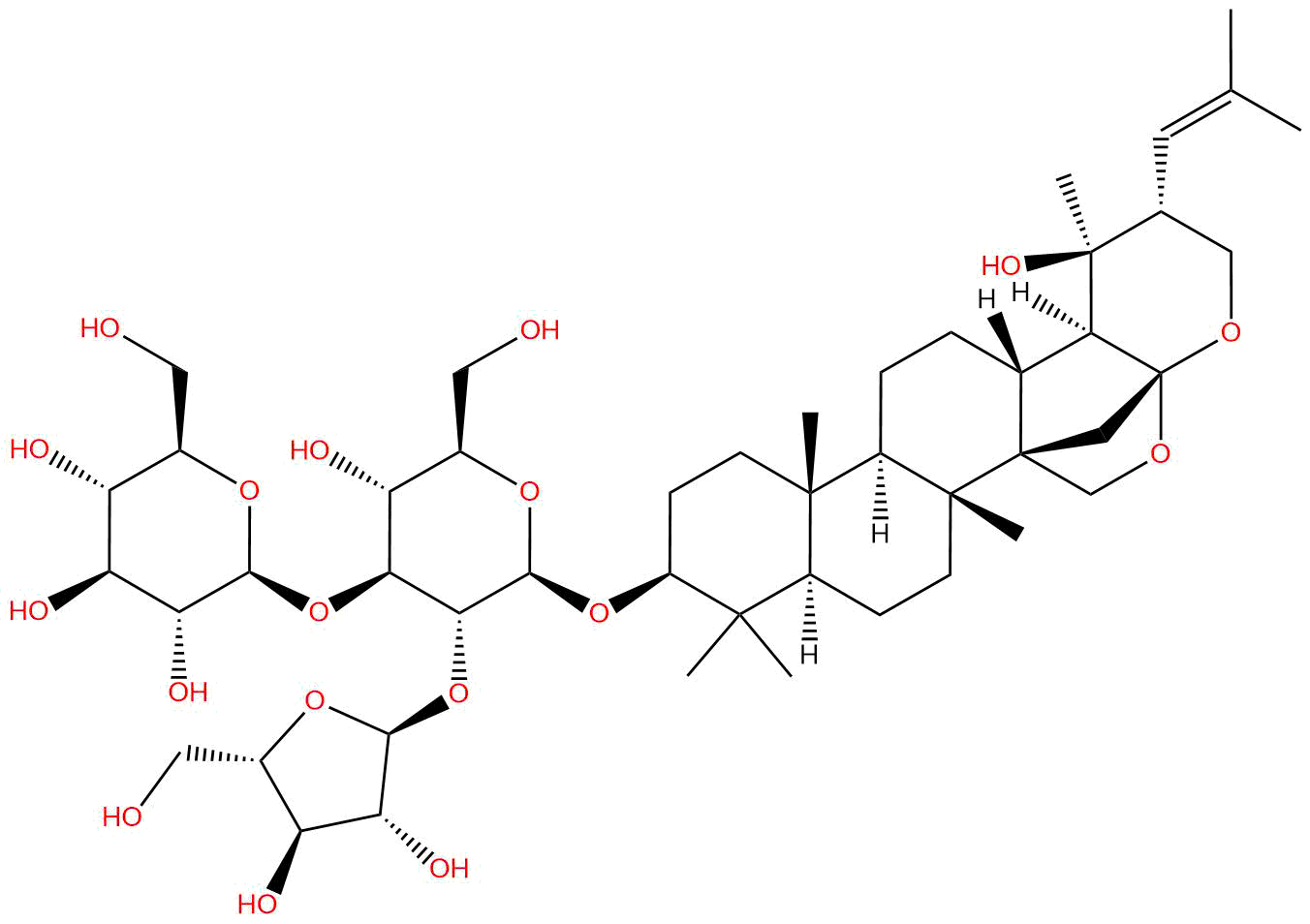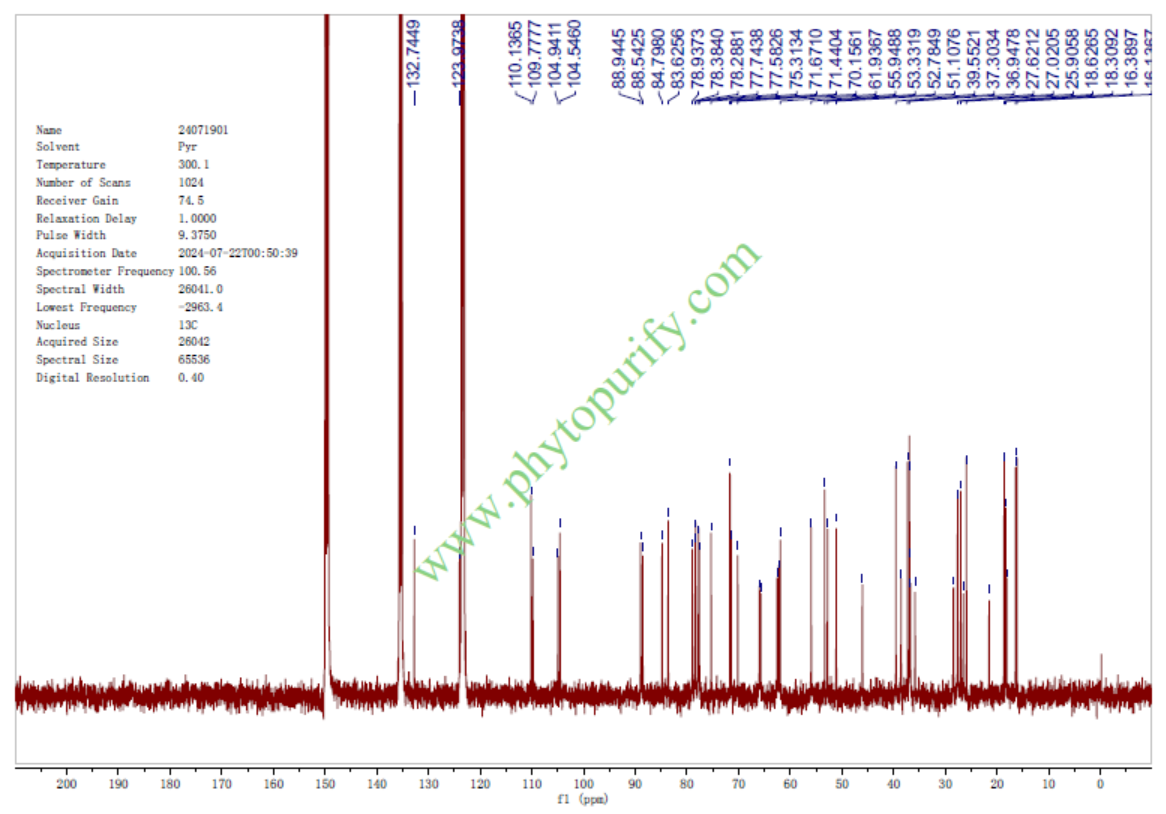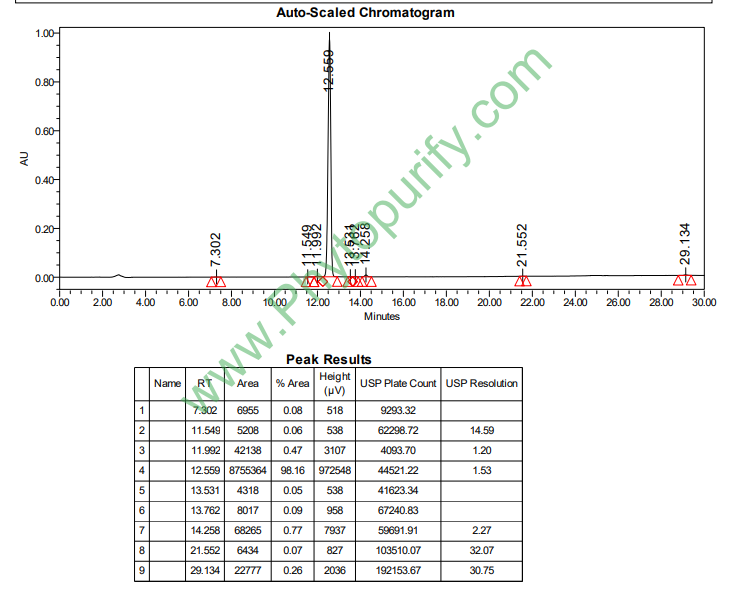
Bacopaside IICAS No.:382146-66-9
|
||||||||||
 |
|
|
||||||||

| Catalogue No.: | BP0227 |
| Formula: | C47H76O18 |
| Mol Weight: | 929.107 |
Synonym name: Bacopaside II
Catalogue No.: BP0227
Cas No.: 382146-66-9
Formula: C47H76O18
Mol Weight: 929.107
Botanical Source: Bacopa monnieri
Purity: 95%~99%
Analysis Method: HPLC-DAD or/and HPLC-ELSD
Identification Method: Mass, NMR
Packing: Brown vial or HDPE plastic bottle
Can be supplied from milligrams to grams.
For Reference Standard and R&D, Not for Human Use Directly.
Inquire for bulk scale.
Description:
Bacopaside II is a potential anti-angiogenic agent, it can reduce endothelial cell migration and tubulogenesis and induce apoptosis. Bacopaside II shows antioxidant and antidepressant activities, it can inhibit both basal activity as well as verapamil-stimulated ATPase activity, suggesting its affinity towards P-gp.
References:
Int J Mol Sci. 2018 Feb 26;19(3). pii: E653.
The Aquaporin 1 Inhibitor Bacopaside II Reduces Endothelial Cell Migration and Tubulogenesis and Induces Apoptosis.
Expression of aquaporin-1 (AQP1) in endothelial cells is critical for their migration and angiogenesis in cancer.
METHODS AND RESULTS:
We tested the AQP1 inhibitor, Bacopaside II, derived from medicinal plant Bacopa monnieri, on endothelial cell migration and tube-formation in vitro using mouse endothelial cell lines (2H11 and 3B11) and human umbilical vein endothelial cells (HUVEC). The effect of Bacopaside II on viability, apoptosis, migration and tubulogenesis was assessed by a proliferation assay, annexin-V/propidium iodide flow cytometry, the scratch wound assay and endothelial tube-formation, respectively. Cell viability was reduced significantly for 2H11 at 15 μM (p = 0.037), 3B11 at 12.5 μM (p = 0.017) and HUVEC at 10 μM (p < 0.0001). At 15 μM, the reduced viability was accompanied by an increase in apoptosis of 38%, 50% and 32% for 2H11, 3B11 and HUVEC, respectively. Bacopaside II at ≥10 μM significantly reduced migration of 2H11 (p = 0.0002) and 3B11 (p = 0.034). HUVECs were most sensitive with a significant reduction at ≥7.5 μM (p = 0.037). Tube-formation was reduced with a 15 μM dose for all cell lines and 10 μM for 3B11 (p < 0.0001).
CONCLUSIONS:
These results suggest that Bacopaside II is a potential anti-angiogenic agent.
Heliyon. 2016 Feb 15;2(2):e00068.
Beneficial effects of Bacopa monnieri extract on opioid induced toxicity.
The present study examined the hepatotoxicity and nephrotoxicity of morphine and illicit street heroin and their amelioration by a standardized methanolic extract of Bacopa monnieri (L.) (mBME) in rats.
METHODS AND RESULTS:
Morphine or street heroin was administered at a dose of 20 mg/kg for 14 and 21 days. mBME (40 mg/kg) or ascorbic acid (50 mg/kg) was administered two hours before morphine or street heroin. High performance liquid chromatography (HPLC) was used for the standardization of bacoside-A major components in mBME. The antioxidant potential of mBME was evaluated by 2,2-diphenyl-1-picrylhydrazyl (DPPH) free radical scavenging assay. Administration of morphine and street heroin resulted in marked elevation of serum alanine aminotransferase (ALT), aspartate aminotransferase (AST) and creatinine. Histopathological changes induced by morphine and street heroin after 14 days were of reversible nature while treatment for 21 days was associated with irreversible changes. Pretreatment with mBME or ascorbic acid restored the elevation of serum ALT, AST and creatinine and protected liver and kidneys from the toxicological influence of morphine and street heroin. HPLC analysis showed that mBME contained bacoside-A major components i.e. bacoside A3 (37.5 μg/mg), Bacopaside II (4.62 μg/mg) and bacopasaponin C (1.91 μg/mg). The EC50 for the DPPH free radical scavenging assay revealed that mBME possessed strong antioxidant potential.
METHODS AND RESULTS:
These results concluded that as compared to morphine, street heroin was associated with severe biochemical and histopathological changes in the liver and kidneys. Bacopa monnieri having strong antioxidant potential may provide a beneficial herbal remedy for the efficient management of opioid related hepatotoxicity and nephrotoxicity.
NMR of Bacopaside II

HPLC of Bacopaside II
